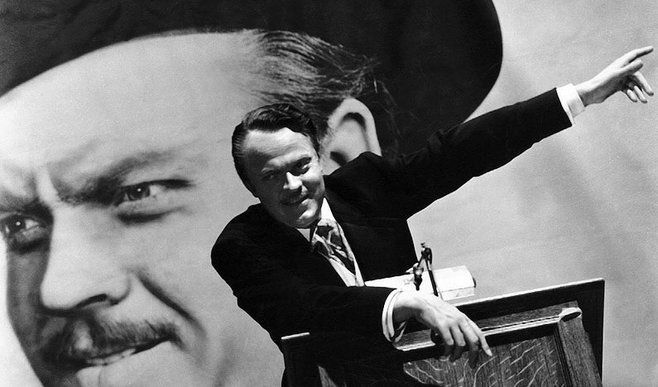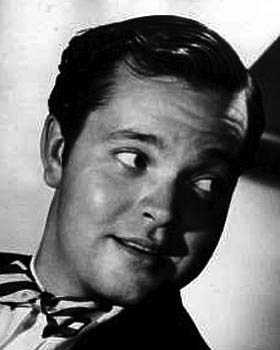Directed by Orson Welles
Written by Orson Welles and Herman J Manciewicz
Cinematography by Gregg Toland
Edited by Robert Wise
Music by Bernard Herrmann
Starring Orson Welles, Joseph Cotten, Agnes Moorehead, Dorothy Comingore, Everett Sloane, Ruth Warrick
A shot of a wired fence with a No Tresspassing sign on it and a castle in the distance dissolves into another shot that takes us on the other side of the fence- we have defied the warning.
The very opening shot of Orson Welles' debut feature Citizen Kane strangely evokes his own non-conformist nature. He was, in a way, signifying through the very first couple of shots that he was going to break all the rules that hitherto existed in the Hollywood tradition of filmmaking.
The film, as we all now know it, is a character sketch of Charles Foster Kane, the newspaper baron and pioneer of yellow journalism, from the perspective of a newsreel, Kane's guardian Mr Thatcher's manuscript, and testimonies provided by his associates and partners, interviewed by a journalist who wants to know what Rosebud, Kane's dying word, is all about. While neither of them has a clue, the audience finally gets to see at the end of the film what it is all about.
The story of how George Orson Welles, an amateur theatre and radio artist, grabbed a Hollywood project at age 24- a deal which most people could only dream of -is the stuff of legend. Welles had already gained fame and notoriety for staging Shakespeare's Macbeth using a team of Afro-American actors, and for his radio adaptation of HG Wells' War of the Worlds, which drove an entire city wild with panic. His approach to his first movie project was also in the same spirit of rebellion, and that is exactly what makes Citizen Kane such an enduring film.
Another fact about the film that is enshrined in legend is that the film takes several digs at William Randolf Hearst, the real-life press baron still living at the time, who made a marketable commodity out of journalism. Another side of the mogul that was extensively caricatured in the film was his relationship with his mistress, actress Marion Davies, who was portrayed as Susan Alexander, a singer in the film.
While the premise in itself had enough to give it notoriety, Welles looked for more. Another factor that gave Kane its notoriety upon its release and which is one of the reasons the film is celebrated today is its technique. The film made extensive use of fragmentary flashbacks, cunning editing (the abrupt cut from Kane's deathbed to the obituary newsreel; a 10-year-old Kane wishing Thatcher Merry Christmas to Thatcher wishing Happy New Year to a 25-year-old Kane), expressionist lighting, an unconventional soundtrack, deep focus photography and single take coverage of scenes. All this, packed into a two hour movie, seemed too much for the audience of 1941 to take in, and Citizen Kane failed at the box office.
But this notoriety turned into renown in a few years' time, thanks to the critics' championing of the film (Andre Bazin, especially, was bowled over by the film's use of deep space, so was Bosley Crowther of the New York Times), and especially by the interviews delivered by Welles and his DP Gregg Toland. That, and the relative oblivion of non-Hollywood films in the international film scene helped Kane in being reputed as the first film that made use of the effects mentioned above. It also won acclaim as being the first film that showed the ceilings of sets.
But as time has now proved, several of these innovations were already in place in other filmmaking cultures. Post-50s, the proliferation of film festivals and international film culture revealed that Mizoguchi and Ophuls were already pioneers of the long take, Renoir had perfected deep focus photography in The Rules of the Game, and Yasujiro Ozu was showing the ceilings of sets years before Kane was released. Despite these revelations, Welles' film continued to be voted as the greatest film ever made for over 50 years, until Hitchcock's Vertigo toppled it in the Sight and Sound list of 2012.
This surely does not mean that Citizen Kane is not a great film, for it truly is one of the twentieth century's great works of art that demands analysis yet defies it. While the several innovations the film is credited with was already in place in several filmmaking traditions around the world, Welles, as he himself admitted in an interview, had the advantage of total ignorance of their use by other directors and hence, made use of them in his own, original way. Besides, he had the expertise of cinematographer Gregg Toland by his side, to whom he would ever remain indebted.
Written by Orson Welles and Herman J Manciewicz
Cinematography by Gregg Toland
Edited by Robert Wise
Music by Bernard Herrmann
Starring Orson Welles, Joseph Cotten, Agnes Moorehead, Dorothy Comingore, Everett Sloane, Ruth Warrick
A shot of a wired fence with a No Tresspassing sign on it and a castle in the distance dissolves into another shot that takes us on the other side of the fence- we have defied the warning.
The very opening shot of Orson Welles' debut feature Citizen Kane strangely evokes his own non-conformist nature. He was, in a way, signifying through the very first couple of shots that he was going to break all the rules that hitherto existed in the Hollywood tradition of filmmaking.
The film, as we all now know it, is a character sketch of Charles Foster Kane, the newspaper baron and pioneer of yellow journalism, from the perspective of a newsreel, Kane's guardian Mr Thatcher's manuscript, and testimonies provided by his associates and partners, interviewed by a journalist who wants to know what Rosebud, Kane's dying word, is all about. While neither of them has a clue, the audience finally gets to see at the end of the film what it is all about.
The story of how George Orson Welles, an amateur theatre and radio artist, grabbed a Hollywood project at age 24- a deal which most people could only dream of -is the stuff of legend. Welles had already gained fame and notoriety for staging Shakespeare's Macbeth using a team of Afro-American actors, and for his radio adaptation of HG Wells' War of the Worlds, which drove an entire city wild with panic. His approach to his first movie project was also in the same spirit of rebellion, and that is exactly what makes Citizen Kane such an enduring film.
Another fact about the film that is enshrined in legend is that the film takes several digs at William Randolf Hearst, the real-life press baron still living at the time, who made a marketable commodity out of journalism. Another side of the mogul that was extensively caricatured in the film was his relationship with his mistress, actress Marion Davies, who was portrayed as Susan Alexander, a singer in the film.
While the premise in itself had enough to give it notoriety, Welles looked for more. Another factor that gave Kane its notoriety upon its release and which is one of the reasons the film is celebrated today is its technique. The film made extensive use of fragmentary flashbacks, cunning editing (the abrupt cut from Kane's deathbed to the obituary newsreel; a 10-year-old Kane wishing Thatcher Merry Christmas to Thatcher wishing Happy New Year to a 25-year-old Kane), expressionist lighting, an unconventional soundtrack, deep focus photography and single take coverage of scenes. All this, packed into a two hour movie, seemed too much for the audience of 1941 to take in, and Citizen Kane failed at the box office.
But this notoriety turned into renown in a few years' time, thanks to the critics' championing of the film (Andre Bazin, especially, was bowled over by the film's use of deep space, so was Bosley Crowther of the New York Times), and especially by the interviews delivered by Welles and his DP Gregg Toland. That, and the relative oblivion of non-Hollywood films in the international film scene helped Kane in being reputed as the first film that made use of the effects mentioned above. It also won acclaim as being the first film that showed the ceilings of sets.
But as time has now proved, several of these innovations were already in place in other filmmaking cultures. Post-50s, the proliferation of film festivals and international film culture revealed that Mizoguchi and Ophuls were already pioneers of the long take, Renoir had perfected deep focus photography in The Rules of the Game, and Yasujiro Ozu was showing the ceilings of sets years before Kane was released. Despite these revelations, Welles' film continued to be voted as the greatest film ever made for over 50 years, until Hitchcock's Vertigo toppled it in the Sight and Sound list of 2012.
This surely does not mean that Citizen Kane is not a great film, for it truly is one of the twentieth century's great works of art that demands analysis yet defies it. While the several innovations the film is credited with was already in place in several filmmaking traditions around the world, Welles, as he himself admitted in an interview, had the advantage of total ignorance of their use by other directors and hence, made use of them in his own, original way. Besides, he had the expertise of cinematographer Gregg Toland by his side, to whom he would ever remain indebted.



No comments:
Post a Comment